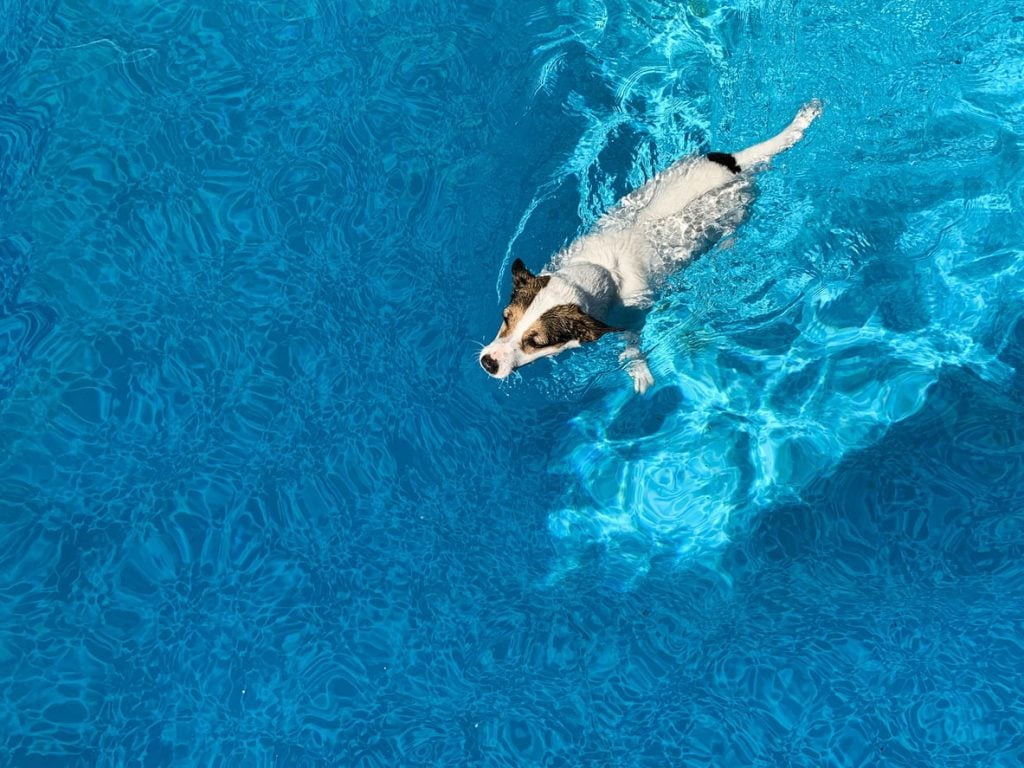- Not a substitute for professional veterinary help.
Has your dog’s tail gone oddly still and limp? They might have limber tail, which is essentially when a dog sprains their tail muscles after overuse. Limber tail usually goes away with rest within 2-14 days. “It rarely signals a serious or recurring health problem, but dogs that have had it once may be prone to subsequent episodes if they undertake the same strenuous activity,” says Michael Thompson, DVM, veterinarian and founder of Pets Food Safety.
Limber tail, or swimmer’s tail, can be painful, so it’s best for your dog to avoid it when possible. Make sure to always give your dog breaks during exercise, especially during cold weather.
Below, we’ll discuss the symptoms of swimmers tail in dogs and how to treat it.
What is Limber Tail?
The scientific name for limber tail is acute caudal myopathy. “Acute” means the condition is short-term. “Caudal myopathy” means it affects your dog’s caudal muscles at the base of their tail.
Other names for limber tail include:
- Swimmer’s tail
- Cold-water tail
- Broken wag
- Sprung tail
- Sprained tail
What are The Symptoms of Limber Tail?
The telltale sign of a limber tail is its flaccid appearance. Your dog’s tail may be completely or partially limp. A partially limp tail will be stiff and horizontal at the base but hang down at the tip.
Other signs your dog has limber tail include:
- Whining or whimpering from pain
- Licking or chewing their tail
- Reluctance to let anyone touch or move their tail
- Inability to wag their tail
- Unusual tiredness

iStock/Sergii Petruk
What Causes Limber Tail?
Limber tail affects your dog’s caudal muscles and tendons that sit at the base of the tail and extend along its length. “They play a critical role in enabling the tail’s various movements, including wagging, lifting, and lowering,” says Maria Baker, DVM, veterinarian at pet-how.com.
Additionally, she says these muscles are susceptible to damage from strenuous activities like prolonged swimming; this is why limber tail is often referred to as swimmer’s tail. During the activity, your dog uses their tail as a rudder to steer in the water, so these muscles can get exhausted quickly.
But limber tail isn’t restricted to over-exercise or swimming. Other causes include the following.
- Chilly weather: Excess cold can damage your dog’s muscles, including those in their tail, making them prone to injury.
- Extended crate time: Just like your legs get stiff after a long car ride, your dog’s tail can get bent out of shape after too much time in a crate.
- Too much wagging: An over-excited dog could sprain their tail by wagging it too hard.
Are certain breeds more likely to get limber tail?
Larger hunting and sporting dogs are more prone to limber tail due to their activity level. English Pointers and Labrador Retrievers tend to sprain their tails the most. However, smaller breeds like Beagles can also get limber tail.
How Do Vets Diagnose Limber Tail?
A limp tail will frequently resolve itself without much fuss. “Dog [parents] should wait 24 hours before visiting the vet, provided they see no other alarming symptoms like pain or refusal to eat,” Dr. Thompson says.
A vet can determine if your dog has limber tail or something else. First, they’ll ask you about your dog’s recent activities. Then, they’ll provide a physical examination. Dr. Baker says during the exam, they’ll feel the tail for any pain, swelling, or other abnormalities. Depending on their findings, your vet may also x-ray your dog’s tail.
What Other Medical Issues Cause a Limp Tail?
Sometimes a flaccid tail can be a sign of more serious issues, including the following.
- Tail injury: Skinny tails can get hurt easily if they hit a hard object while wagging. This can damage the blood vessels inside and interrupt blood flow to the tail.
- Tail fracture: Trauma to the tail, such as getting caught in a slamming door, can break the bones inside.
- Cauda equina syndrome: The cauda equina is the section of the spinal cord and nerves in your dog’s tail. Sometimes the bones in your dog’s spine become narrow, squeezing the cauda equina and making it hard for your dog to move their tail.
- Intervertebral disc disease (IVDD): Damage to the discs in your dog’s spine can restrict movement in the back half, including the tail. This issue is more common in older dogs.
- Impacted anal glands: Sometimes, scent glands around your dog’s anus can get clogged. Your dog may chew and lick their tail area to try and relieve pain.
- Prostatitis: The prostate gland in male dogs sits close to their tail. Bacterial infection can make this gland inflamed, creating pressure and pain in the tail area.
- Prostate cancer: Prostate cancer is very rare, affecting 0.3%-0.6% of all dogs. However, it can force your dog to hold their tail in an unusual position.
Your vet can guide you on the best treatment for your dog’s limp tail.
How Does a Vet Treat Limber Tail?
“Rest is the first and foremost treatment for limber tail,” says Dr. Baker. If you have a working dog, now’s a good time to give them a vacation. Try to avoid intense play such as wrestling, running, or swimming.
Most cases of limber tail are mild and will go away on their own. You can give your dog an ice pack and extra pets if they are feeling sore. However, serious sprains may require pain medication. Dr. Baker says your vet may prescribe the following for severe limber tail:
- Nonsteroidal anti-inflammatory drugs (NSAIDs) like carprofen or meloxicam
- Opioid pain relievers, such as tramadol
- Muscle relaxants, if spasms are present
“Over-the-counter pain relievers like acetaminophen should only be used under veterinary guidance, as they can be toxic to dogs in incorrect doses,” she explains.

iStock/Veronika Gaudet
How to Prevent A Dog’s Limp Tail
Dogs recovering from limber tail can sprain their muscles again if they return to the same routine too quickly. “Prevention is the best medicine,” says Dr. Thompson.
Here are some tips to protect your dog’s tail in the future:
Ease back into swimming
“After recovering from a limber tail, I recommend a minimum rest period of two weeks before the dog starts swimming again,” says Dr. Thompson. He recommends easing your dog back into swimming, starting with shorter sessions of 20-30 minutes.
Give them exercise breaks
Land exercises can also sprain tail muscles, so be careful not to overwork your dog. Check that their exercise regimen suits their current age and breed. Remember that even the most active dog still needs breaks!
Keep them warm
Breeds with short hair or low bodies (like Beagles) are more vulnerable to cold. You can prevent hypothermia by dressing your dog for the weather. Make sure they have a solid coat or sweater, and consider adding some boots for their paws.
Get the right-sized crate
Getting a large enough crate lets your dog lie down without bending their tail at awkward angles. Measure your dog from their nose to the base of their tail, then add 2-5 inches in length to get the right size. No matter what kind of crate you have, make sure to let your dog out at least every 4 hours.
Avoid excitable situations
Lastly, you may want to avoid situations that make your pet over-excited, such as the dog park, until their tail has recovered. However, once a happy dog starts wagging their tail, there’s really no stopping them!



